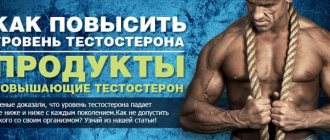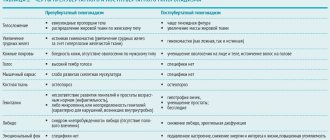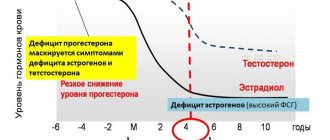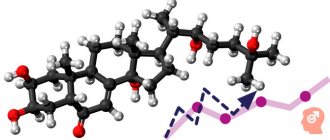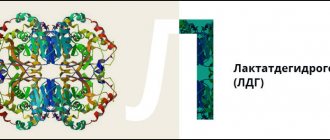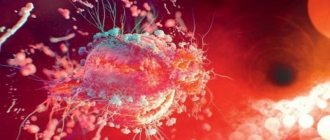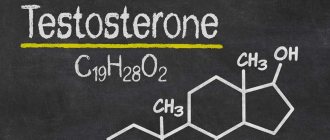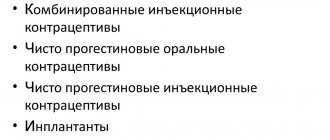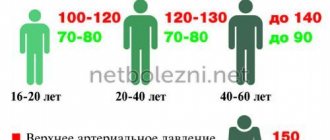Stimulant therapy
Stimulant therapy is aimed at increasing the production of a man's own testosterone in the testicles. For this purpose, human chorionic gonadotropin preparations obtained from the pituitary gland of cattle are used. They are analogues of male luteinizing hormone, produced in the pituitary gland of the male brain.
This group of drugs includes:
- domestic Chorionic Gonadotropin (produced by the Federal State Unitary Enterprise "Moscow Endocrine Plant")
- imported drug Horagon (manufactured by Ferring, Germany).
The dose and frequency of administration of the drug depend on the age, weight of the patient and the initial level of male testosterone.
Prescription drugs, dispensed according to a doctor's prescription.
When do hormone levels increase?
In women, a slight increase in hormone levels can be observed when taking COCs (combined oral contraceptives), as well as during pregnancy. In both men and women, increased testosterone is a consequence of taking anticonvulsants (for example, therapy for epilepsy), as well as during treatment for hyperthyroidism.
An increase in testosterone is a clear signal that allows one to suspect the development of the following conditions in a patient:
- development of adrenogenital syndrome in women;
- the risk of tumor formation in the ovaries in women and testicles in men;
- Itsenko-Cushing's disease ¾ endocrine pathology, in which there is excessive synthesis of ACTH (adrenocorticotropic hormone) at the level of the brain, which leads to increased activity of the adrenal cortex, where, in particular, testosterone is produced;
- Reifenstein syndrome (male pseudohermaphroditism);
- tumor process in the pituitary gland;
- excessive physical activity of patients;
- in some professional athletes taking steroid drugs.
Increased testosterone ¾ is an important symptom that cannot be ignored. When testosterone increases, the doctor, as a rule, conducts additional diagnostics to find out the reasons for the change in the level of the hormone in the patient’s body.
Hormone replacement therapy
Androgen hormone replacement therapy involves replenishing testosterone deficiency with various dosage forms of artificial testosterone.
Short-acting testosterone preparations:
- Sustanon-250 (manufactured by Organon , the Netherlands) – 1.0 ml. an oil solution of four testosterone esters, differing in the rate of delivery and duration of action.
- Omnadren-250 (manufactured by Jelfa , Poland) – 1.0 ml. oil solution of two testosterone esters, differing in the rate of entry into the blood and duration of action
After a single intramuscular injection, a sufficient concentration of testosterone in the blood is maintained for no more than 14 days.
Long-acting testosterone preparation:
- Nebido (manufactured by Bayer , Germany). Available in 4.0 ml bottles. testosterone undecanoate oil solution
After a single intramuscular injection, it maintains the physiological concentration of testosterone in the blood for 10 to 14 weeks.
Cutaneous form of testosterone
- Cutaneous form of testosterone in the form of Androgel gel (manufactured by Besins International Belgigue, Belgium). Available in the form of a gel in 5.0 gram bags. It is applied to certain areas of the skin and provides a stable physiological concentration of the hormone in the blood for 24 hours.
All dosage forms of testosterone are prescription drugs and are available only with a doctor's prescription.
Today, drugs with a questionable effect on testosterone levels include numerous dietary supplements - dietary supplements based on plant raw materials.
The most well-known plants for their production are: Tribulus terrestris, Ginseng, Eleutherococcus, African creeping palm root, etc. They are produced under different brand names and have more of a general tonic effect than an androgenic one.
A little theory
Artificially increasing testosterone in men allows:
- form more impressive and prominent muscles;
- significantly increase performance and endurance;
- burn excess fat reserves faster;
- as a bonus, improve potency and quality of sexual life.
But in order for the chosen remedy to live up to expectations, it needs help. Make sure that your diet is properly balanced, that your sleep duration is at least 7-8 hours, avoid stress if possible, and give up bad habits.
Know that all means that increase testosterone are divided into two types: some of them stimulate the production of their own hormone, others replace it with a synthetic analogue.
In any case, you need to select the complex together with your doctor, after passing the appropriate blood test. And this should be done after 25-30 years, since before this age the body already has enough natural testosterone. In addition, almost every remedy has contraindications, which once again indicates the need to choose them in consultation with a specialist.
Keep in mind that it is not always possible to find such drugs in a pharmacy; we recommend that you immediately look for them in online or offline sports nutrition stores.
There are many myths about how to increase the male hormone testosterone!
Does frequent sexual intercourse increase testosterone?
Doubtful! Quite the contrary: a good level of male hormone in the blood maintains high libido and stimulates sexual activity. A naturally programmed decrease in the level of androgens in the blood by 1-2% per year in all men, without exception, inevitably leads to a decrease in sexual desire and sexual activity.
Drugs from the group of PDE-5 inhibitors (Viagra, Levitra, Zidena, Cialis) increase hormone levels.
Doubtful! The point of application for this group of drugs is the vessels of the male body, including the vessels and cavernous bodies of the penis, but not the hormonal organs. If androgen deficiency in a man is not treated, then the effect of taking Viagra will disappear sooner or later.
Overweight and obesity do not affect the male hormone.
Dangerous misconception! Adipose tissue contains the enzyme aromatase. Aromatase converts male testosterone into the female hormone - Estradiol. The more fat, respectively, the more aromatase a man has, the more testosterone will be converted into female sex hormones. An obese man, at any age, never has normal levels of androgen hormones!
Testosterone drugs cause prostate cancer.
The most persistent myth that migrated from the 20th century to the 21st century! Modern scientific research states the following: The risk of developing prostate cancer in men receiving artificial testosterone drugs and in men without hormone replacement therapy is absolutely the same. But the degree of malignancy of prostate cancer (if it occurs) in men without hormone replacement therapy is many times higher than in men receiving artificial testosterone!
The formula of synthetic testosterone is similar to testosterone from the testicles. Answer a simple question: Why didn't you develop prostate cancer at a young age when your male hormone levels were high? The risks of prostate cancer, like other forms of cancer, increase with age, not with blood testosterone levels.
Review of the 10 best drugs to increase testosterone
Let's look at ten good drugs to increase testosterone in men, namely:
- Testoboom;
- ZM8+;
- ZMA Sleep Max;
- Tribu-TEC;
- D-aspartic acid;
- Ecdysterone;
- Z-Force;
- ZMA Pro;
- Yohimbe;
- Myotest.
Testoboom
This is a booster of natural origin from the British brand Vplab. It contains zinc in citrate form, Peruvian maca root and wild yam. A jar lasts for 3 months.
Take Testoboom capsules after meals with plenty of water. The dosage is determined individually and can range from one to three pieces per day. The full course of daily use is 1 month.
ZM8+
This is a vitamin and mineral complex from the Canadian brand Mutant. It includes vitamins D, B6, B12, as well as magnesium, zinc, selenium, manganese, chromium, a patented additive +BioPerine® and black pepper extract. The jar holds 45 servings.
You need to take ZM8+ capsules at night, on an empty stomach, 2-3 pieces, with a glass of purified water. The course lasts two months, after which a month break is required.
ZMA Sleep Max
This complex also belongs to the vitamin-mineral complex, and it was produced by the American company Maxler. The formula contains magnesium, zinc, melatonin, vitamin B6, ginkgo biloba and passionflower extracts. The packaging is designed for a month of use.
The manufacturer advises drinking 3 capsules of ZMA Sleep Max in the evenings, on an empty stomach, about half an hour to an hour before bedtime.
Tribu-TEC
This is a herbal preparation from the Russian brand King Protein. It contains a single active ingredient: Tribulus terrestis extract, rich in steroidal saponins. The jar contains 100 tablets.
Consumption depends on your weight: men up to 80 kg should take 1-2 tablets per day, about half an hour before meals, with water. Those who weigh more drink 2-3 pieces.
D-Aspartic Acid Powder
This is an amino acid powder booster from the domestic brand GeneticLab. Its formula is also based on one ingredient - D-aspartic acid. The package contains 100 g of product.
You need to take D-Aspartic Acid half a measuring spoon, diluting the powder in a glass of water. Do this in the morning, on an empty stomach, or immediately after waking up. The course lasts 1-1.5 months.
Ecdysterone
This is also a Russian drug from the company GeneticLab. It combines plant extracts and vitamins. In particular, the composition contains vitamins B2, B6 and PP, extracts of Leuzea safflower and grape seeds. The jar contains 60 capsules.
The manufacturer recommends taking one capsule of Ecdysterone per day with food.
Z-Force
This is a vitamin and mineral complex from the American brand Dymatize Nutrition. This includes ascorbic acid, vitamin E, B6, iron, magnesium aspartate, zinc, sodium. The jar is designed for three months of use.
You need to take Z-Force capsules once, three at a time, in the evenings, 30-40 minutes before bedtime, ideally on an empty stomach.
ZMA Pro
Another American vitamin and mineral complex, this time from the SAN brand. Its formula includes magnesium, zinc and vitamin B6. The jar contains 90 capsules.
You should take one capsule, two or three times a day, preferably at approximately equal intervals. The last dose should be at night, half an hour before bedtime, on an empty stomach. Do not combine with calcium intake!
Yohimbe
This is a vitamin and mineral complex produced by the Russian company CyberMass. It contains inositol, L-carnitine, choline, vitamin B6, chromium picolinate, limonene. There are 100 capsules in a jar, which is enough for 50 days of use.
You need to take Yohimbe twice a day, one piece at a time. You can do this in the morning and at lunch before meals, or half an hour before the start of training and 30-40 minutes before meals.
Myotest
And again, a testosterone booster from the USA, from the SAN brand. It contains zinc, quercetin, icariins, resveratrol, indole-3-carbinol, and nettle extract. The package contains 90 capsules.
You need to drink them 3 pieces at a time, two to three times a day, with meals. You cannot exceed the maximum daily dose of 9 capsules!
Now, if you want to purchase drugs to increase testosterone at a pharmacy or specialty store, you will know which ones to pay attention to. Good luck!
Pitfalls of testosterone therapy
26.04.2018
97823
3
In the next episode of the program “An Hour with a Leading Urologist” Stepan Sergeevich Krasnyak, employee of the Department of Andrology and Human Reproduction of the Research Institute of Urology and Interventional Radiology named after. N.A. Lopatkina of the Russian Ministry of Health, spoke about the problems associated with prescribing hormonal replacement therapy with testosterone drugs in men.
As Stepan Sergeevich noted at the beginning of his speech, the topic of testosterone therapy is extremely controversial and raises many questions among both doctors and patients. The prevalence of testosterone therapy today is growing rapidly, but the negative aspects of such treatment, according to the guest of the program, are often forgotten.
S.S. Krasnyak recalled the main areas of influence of testosterone on the male body. In particular, this hormone provokes the growth of body hair, is involved in the synthesis of whey proteins in the liver, causes enlargement of the penis and triggers spermatogenesis, affects thinking and mood, helps to increase strength and muscle mass, and from the kidneys is involved in the synthesis of erythropoietin, as well as supports bone growth in length and increase in their density. Accordingly, the less testosterone in the body, the less pronounced male sexual characteristics. Fortunately, according to Stepan Sergeevich, the decrease in the amount of this hormone is usually reversible.
Boundary between normality and pathology
It's no secret that testosterone levels tend to decline with age. However, is this process normal or pathological, and where is the line that allows us to distinguish between these two conditions? Most often, problems with testosterone occur in men over the age of 45–50 years. There are a number of criteria for identifying age-related hypogonadism. These include a decrease in serum testosterone (total <11 nmol/l, free <220 pmol/l), erectile dysfunction, decreased libido and decreased frequency of morning erections (EMAS data). The doctor emphasized that testosterone drugs are prescribed to treat not sexual dysfunction or obesity, but hypogonadism as such. The testosterone level threshold for prescribing hormone replacement therapy is 9.7–10.4 and 6.9 nmol/l.
Stepan Sergeevich noted the importance of a personalized approach to the patient: there are people with high receptor sensitivity in whom even low testosterone levels do not cause clear clinical manifestations. Accordingly, the question arises as to whether hormonal therapy is needed in such patients. Current clinical recommendations today indicate that, as a rule, it is not necessary. In practice, according to the lecturer, one must proceed from a combination of clinical symptoms, probably associated with low testosterone levels, and its laboratory confirmation. At the same time, it is important to avoid uncontrolled and excessive prescription/reception of testosterone.
In general, cases of symptom discrepancy (20–40% of the general population) and low circulating testosterone levels (20% of men > 70 years) are quite common. According to these criteria, only 2% of people aged 40 to 80 years have age-related hypogonadism and actually need testosterone therapy.
Hormone replacement therapy – billions of dollars
Today, testosterone replacement therapy is widely used throughout the world to treat hypogonadism and associated isolated symptoms. The alarming aspect of this trend, however, is that it has emerged without any serious scientific evidence regarding the benefits and risks of this type of therapy.
Today, injectable and gel testosterone preparations are mainly used. In the United States, sales of testosterone preparations between 2005 and 2010 has doubled and continues to grow. Similar trends can be seen all over the world. From 2000 to 2011, total sales of testosterone in the world increased 12 times to $1.8 billion. According to forecasts, in 2021, sales of testosterone preparations in the United States alone will amount to $3.8 billion. Inevitably, as Stepan Sergeevich noted, the question arises: is it really Have men become so much more likely to suffer from hypogonadism lately? It is possible that large scale overtreatment is occurring.
The doctor also spoke about the presence of scattered but numerous data indicating an increasing trend in the number of patients suffering from obesity associated with taking testosterone.
Replacement therapy, Stepan Sergeevich emphasized, should be offered to the patient only after a conversation that in the long term the beneficial and unfavorable consequences of this treatment for him are unknown. Thus, in 2021, at the Congress of the American Urological Association, a so-called urological “trial” was held, where, with the participation of practicing lawyers, a case of prescribing testosterone drugs to a patient with a high risk of cardiovascular diseases was examined, which ultimately led to his death. Interestingly, virtually no somatic diseases are contraindications to hormonal therapy. However, the doctor emphasized, this does not mean that it should be prescribed to everyone, including the most severely ill patients. Patients with a high risk of concomitant diseases must undergo specialized studies.
It is also noteworthy that many of the studies available on the topic today included men without symptoms of hypogonadism, while various testosterone thresholds, drugs, and dosage regimens were used for evaluation. Thus, it is very difficult to bring together data that would allow an objective assessment of the safety of testosterone therapy.
About pitfalls
At the very least, there are absolute contraindications for prescribing HRT. These include prostate and breast cancer, as well as liver tumors. Relative contraindications include prostate-specific antigen (PSA) level >4 ng/ml (or 3 ng/ml in men at high risk of developing prostate cancer); hematocrit >50%; severe lower urinary tract symptoms caused by benign prostatic hyperplasia (above 19 points on the IPSS scale); and poorly controlled congestive heart failure and sleep apnea.
There is some evidence that testosterone supplements increase prostate volume, ultimately causing a modest increase in PSA levels in older men. In 2005, the Journal of Gerontology published a report showing that the total number of prostate-related adverse events (prostate biopsies, cancer, serum PSA levels greater than 4 ng/mL, increased IPSS scores) was significantly higher in the group of patients those receiving testosterone than those receiving placebo (odds ratio 1.90; 95% CI 1.11–3.24; p<0.05). There are also data showing the results of testosterone supplementation in patients with locally advanced and metastatic prostate cancer (PCa). According to these data, in patients with aggressive and non-aggressive forms of the disease, the levels of total testosterone and sex hormone binding globulin were significantly different: in patients with an aggressive form of prostate cancer, testosterone levels were significantly higher. It is unclear whether we can talk about a cause-and-effect relationship here, but the fact of correlation has been revealed.
Another significant factor is hepatotoxicity. It is because of this that oral forms of testosterone preparations are prohibited in most countries today. Their use has been associated with the development of liver failure, benign and malignant liver neoplasms, intrahepatic cholestasis, hepatic purpura, hepatocellular adenoma and carcinoma.
In addition, a factor such as polycythemia was noted. A very common complication of taking testosterone drugs is erythrocytosis (hematocrit greater than 50%). Two meta-analyses performed in recent years have shown significant negative effects of testosterone therapy compared with placebo in this regard. There is a correlation between high testosterone levels and high hemoglobin levels. Erythrocytosis is more often dose-dependent and develops in older men during therapy with injectable forms of testosterone. The risk of such complications is especially high in the presence of other chronic diseases, for example, chronic obstructive pulmonary disease. Therefore, when prescribing testosterone drugs, control blood tests should be performed.
As for the effect of testosterone drugs on the cardiovascular system, this issue remains controversial. Due to the steady increase in cardiovascular mortality rates, it becomes especially acute. There is, in particular, evidence that testosterone intake correlates with the progression of heart failure, but the cause-and-effect relationship remains a matter of debate. The use of testosterone in coronary artery disease is thought to have a stimulatory atherogenic effect due to its negative effect on the lipid profile. However, normal physiological levels of testosterone have been shown to be beneficial for the male heart, and low levels are associated with an adverse risk of coronary disease outcomes. But, as S.S. Krasnyak emphasized, it is impossible to guarantee that a particular patient will achieve exactly the physiological level of testosterone without serious fluctuations.
In 2006, the New England Journal of Medicine published a study of 106 older men with a mean age of 74 years with low total testosterone, limited mobility, a high prevalence of hypertension, obesity, diabetes, pre-existing heart disease, and hyperlipidemia. For 6 months, patients underwent testosterone therapy in daily doses of 5 to 15 g. A placebo group was also allocated. The incidence of cardiovascular events was significantly higher in patients taking testosterone drugs (23% vs. 5%). Thus, Stepan Sergeevich summed up, it is impossible to assert the safety of such therapy, especially long-term therapy, in patients with existing diseases.
Testosterone and Fertility
Another serious issue is the effect of testosterone drugs on male fertility. There is evidence of a decrease in the volume of patients' testicles and a decrease in the number of sperm up to their complete absence (azoospermia) while taking testosterone drugs. In this case, the sperm count most often returns to its original level within 6 months after stopping therapy, but this does not always happen. This is especially important for young men, some of whom take hormonal medications to achieve rapid improvements in physical and athletic performance. Today there are even developments in the use of testosterone drugs as a means of male contraception.
Other factors
An important factor is also changes in the psyche: psychotic symptoms, excessive libido and aggression, in addition to physical and psychological dependence with withdrawal syndrome, quite rarely, but still noted by attending physicians in patients taking testosterone. In this sense, as the doctor noted, the hormone, like many things in the world, has dark and light sides. Taking testosterone may increase the patient's level of entrepreneurship and courage, but may also lead to aggression and suspiciousness. Here a lot depends on the innate qualities of the man himself.
A known side effect of testosterone drugs is gynecomastia. It is associated with the aromatization of testosterone to estradiol in peripheral adipose and muscle tissue. In this case, the ratio of estradiol to testosterone, as a rule, remains normal.
In addition, testosterone replacement therapy is associated with worsening sleep apnea. Its severe forms are a relative contraindication for therapy. In case of occurrence or exacerbation of obstructive apnea, a reduction in the dosage of the drug or discontinuation of therapy is required.
Like any anabolic steroids, testosterone preparations can cause nitrogen, sodium and water retention - the mineralocorticoid effect. Edema in such cases can worsen the condition of patients with heart, liver and kidney diseases.
The use of cutaneous forms of testosterone is associated with the phenomenon of hyperandrogenism in sexual partners of patients. Transdermal formulations may be associated with a range of skin reactions, mainly erythema and pruritus, which are also common with patch use. Intramuscular injections of testosterone, in turn, can cause local soreness and bruising.
Non-drug ways to increase testosterone
In addition to hormone replacement therapy, physical exercise, proper nutrition and regular visits to a urologist help maintain and increase testosterone levels at any age. Stress control also plays an important role. Many patients benefit from, for example, reducing their working hours. If there is a large volume of overtime work, the working day should be reduced to 10 hours. It is useful to spend at least 2 hours a day doing something you love that is not related to work: for example, reading or listening to music.
Regarding physical activity, there is a recent Japanese study (Kumagawa et al., 2015), which showed that after 12 weeks of high physical activity there was a significant increase in testosterone levels without hormone replacement therapy. Another study of 83 men (Trumble, Benjamin C. et al.) found that one hour of chopping wood increased testosterone levels by 48% (P < 0.001). Another work was carried out with the participation of 30 young men aged 18–27 years (Devi S. et al., 2014). They exercised on an exercise bike for 15 minutes a day with a heart rate of 125–150 beats per minute. After 12 weeks of such exercises, an increase in testosterone levels of up to 20% was observed.
There is also evidence that testosterone levels correlate well with waist circumference. Thus, getting rid of excess fat mass will in any case lead to an adjustment in the level of this hormone. It is weight loss that can be considered as a first-line therapeutic measure in patients with hypogonadism caused by obesity. There is a possibility that if weight loss is successful, the man will not need hormone replacement therapy in the future.
In the 21st century, prolonging life and maintaining its quality come to the fore among the tasks of medicine. Accordingly, patients should be given a number of simple recommendations that will help reduce the risk of developing metabolic syndrome and problems with testosterone levels. First of all, a man should change his diet and stop drinking excessively, and approach this systematically, and not as a temporary measure. However, the doctor emphasized, the patient does not need to be severely limited in the consumption of fats, including saturated fats: they are involved in the production of sex steroids, including testosterone. There is evidence of a strong correlation between high-density lipoprotein (HDL) levels and free testosterone levels (Heller, R.).
There are also a number of herbal remedies that have an evidence base for increasing testosterone levels. For example, 14-day consumption of Eurycoma longifolia extract has been shown to increase circulating testosterone levels by 30.2%. Another study found that the same extract increased the number of men with normal testosterone levels from 35.5 to 90.8%. In addition, 6-week consumption of Peruvian maca extract showed an increase in testosterone production by Leydig cells (Ohta Y. et al., 2016).
Stepan Sergeevich, however, noted that he understands the skepticism of some doctors regarding methods other than hormone replacement therapy. But, as he recalled, many of the active ingredients of the drugs synthesized today were initially obtained from plant materials. Therefore, the use of herbal remedies in addition to changing the amount of physical activity, adjusting diet and reducing daily stress levels may well bring results.
Stepan Sergeevich Krasnyak, employee of the Department of Andrology and Human Reproduction, Research Institute of Urology and Interventional Radiology named after. N. A. Lopatkina, Ministry of Health of Russia
The article was published in the journal “Urology Digest” No. 2/2018, pp. 26-34
Topics and tags
Testosterone
Comments
Oreshkov Vasily Sergeevich - 06.13.2018 - 17:42:36
Thank you very much for the informative report
Kiselev Evgeniy Alekseevich - 04/30/2018 - 11:14:14
I came across a statement that a new type of treatment undergoes damped fluctuations in assessment from “panacea” to “ineffective and harmful.” Over time, as application experience accumulates, a balanced position is formed. In the case of testosterone, these fluctuations are apparently far from dying out. Despite the fact that it has been used for about 80 years. Maybe non-medical factors intervene, artificially maintaining disputes?
Chernega Sergey Vasilievich - 04/26/2018 - 18:00:31
Thanks for the informative report
To post comments you must log in or register
